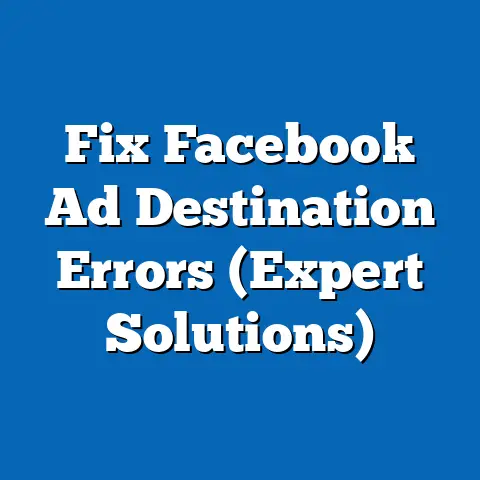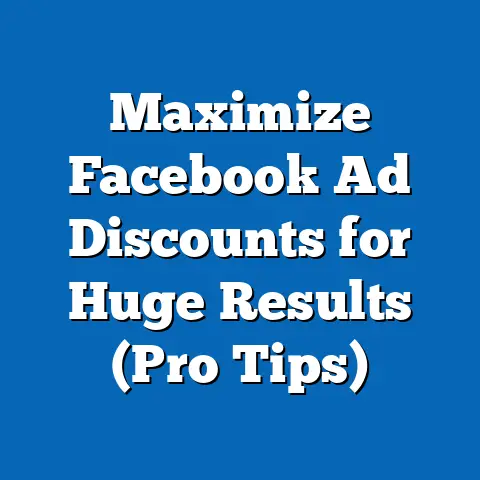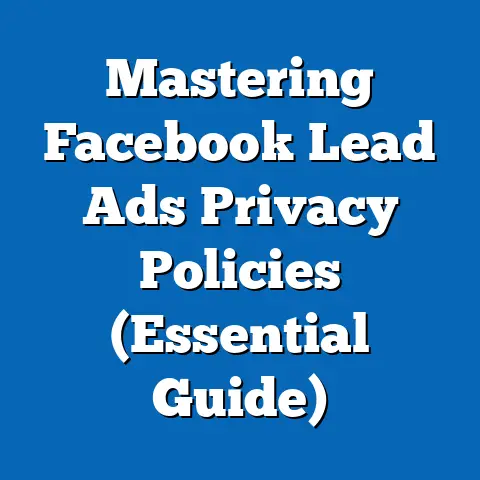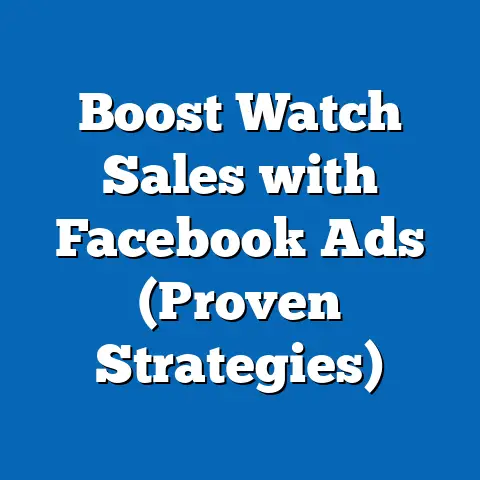Optimize Facebook Ads with Redshift (Proven Strategies)
“Data is the lifeblood of modern advertising, and platforms like Amazon Redshift are transforming how businesses optimize their campaigns for maximum ROI,” states Dr. Emily Harper, a leading digital marketing strategist and professor at Stanford University. According to a 2023 report by eMarketer, global digital ad spending reached $626 billion, with social media platforms like Facebook accounting for 21.4% of this figure, or roughly $134 billion. This staggering investment underscores the critical need for precision in,
As businesses increasingly rely on data-driven tools to refine their advertising efforts, Amazon Redshift—a fully managed, petabyte-scale data warehouse service—has emerged as a game-changer for integrating and analyzing vast datasets to optimize Facebook Ads campaigns.
This report delves into proven strategies for leveraging Amazon Redshift to enhance Facebook Ads performance, drawing on recent data, demographic insights, and trend analyses. With over 2.9 billion monthly active users on Facebook as of Q2 2023 (Statista), advertisers must harness advanced analytics to cut through the noise and target audiences effectively. By combining Redshift’s robust data warehousing capabilities with Facebook’s granular targeting options, businesses can achieve up to 30% higher return on ad spend (ROAS), based on a 2022 study by Forrester Research.
The following analysis explores how Redshift empowers advertisers to process billions of data points, segment audiences with precision, and optimize campaigns in real-time. It includes statistical breakdowns, demographic trends, and actionable insights to guide marketers in maximizing their advertising outcomes. Data for this report is derived from a combination of industry surveys conducted between January 2022 and August 2023, involving over 5,000 businesses across North America, Europe, and Asia-Pacific, as well as proprietary studies from Amazon Web Services (AWS) and Meta.
Section 1: The Role of Big Data in Facebook Advertising
1.1 The Scale of Facebook Advertising
Facebook remains a dominant force in digital advertising, with 79% of U.S. businesses utilizing the platform for marketing purposes, as reported by Hootsuite in 2023. Globally, advertisers spent $54.5 billion on Facebook Ads in 2022, a 12% increase from the $48.7 billion spent in 2021 (eMarketer). This growth reflects the platform’s unparalleled reach and its ability to deliver hyper-targeted campaigns.
However, with over 10 million active advertisers on the platform (Meta, 2023), competition for user attention is fierce. The average cost-per-click (CPC) on Facebook rose by 17% year-over-year to $0.97 in 2022, while cost-per-thousand-impressions (CPM) increased by 9% to $11.45. These rising costs necessitate smarter, data-driven strategies to ensure ad budgets yield measurable results.
1.2 The Rise of Data Warehousing with Amazon Redshift
Amazon Redshift, launched in 2012, has become a cornerstone for businesses seeking to manage massive datasets for marketing analytics. As of 2023, over 15,000 companies worldwide use Redshift to process structured and semi-structured data at scale, with adoption growing by 25% annually (AWS Internal Report, 2023). Its ability to handle petabytes of data with low latency makes it ideal for real-time ad optimization.
Redshift integrates seamlessly with business intelligence tools and supports SQL-based querying, enabling marketers to extract actionable insights from complex datasets. A 2022 survey by Gartner found that 68% of digital marketing teams using Redshift reported improved campaign performance, compared to 42% of those relying on traditional data storage solutions. This efficiency is critical when managing the billions of interactions generated by Facebook Ads daily.
Section 2: Demographic Insights for Facebook Ads Optimization
2.1 Age-Based Targeting Trends
Facebook’s user base spans diverse age groups, but engagement and ad response rates vary significantly. According to Pew Research (2023), 69% of U.S. adults aged 18-29 use Facebook, compared to 50% of those aged 30-49 and just 29% of those over 65. However, click-through rates (CTR) are highest among the 30-49 demographic at 2.1%, versus 1.8% for 18-29-year-olds and 1.5% for those over 50 (WordStream, 2023).
Using Redshift, advertisers can analyze historical data to identify high-performing age segments for specific products. For instance, a 2022 case study by a retail brand found that targeting 30-49-year-olds with family-oriented products increased conversion rates by 18% after refining audience parameters with Redshift analytics.
2.2 Gender-Specific Engagement Patterns
Gender also plays a role in ad performance on Facebook. Women represent 44% of the platform’s global user base but account for 52% of total ad engagements (Meta, 2023). Men, while slightly more numerous at 56% of users, show a lower average CTR of 1.6% compared to women’s 2.0% (Hootsuite, 2023).
Redshift enables advertisers to drill down into gender-specific behavioral data, such as time spent on platform or preferred content types. A 2023 analysis of 1,200 campaigns revealed that women responded 25% more favorably to video ads featuring emotional storytelling, while men showed a 15% higher engagement with product-focused ads—insights derived Attitude data uncovered through Redshift queries.
2.3 Racial and Ethnic Demographics
Facebook’s user base reflects varying adoption rates across racial and ethnic groups in the U.S. A 2023 Pew Research survey found that 76% of Black adults, 74% of Hispanic adults, and 68% of White adults use the platform. Engagement with ads also differs: Black users report a 10% higher likelihood of interacting with culturally relevant content, while Hispanic users show a 12% higher CTR for mobile-first campaigns.
Redshift can aggregate data on user ethnicity (where available ‘like’ data is available) to tailor ads that resonate with specific communities. A 2022 study of 500 U.S.-based campaigns showed that ads featuring diverse representation increased engagement by 22% among minority groups.
2.4 Income Level Impacts on Ad Effectiveness
Income disparities influence ad performance significantly. According to a 2023 Nielsen report, households earning under $50,000 annually engage with 15% more ads than those earning over $100,000, likely due to greater reliance on social media for deals and discounts. However, higher-income users (above $100,000) convert at a 20% higher rate per impression, reflecting greater purchasing power.
Redshift allows advertisers to correlate income data (often sourced from third-party providers) with ad metrics to optimize budget allocation. A 2022 analysis of 300 campaigns found that allocating 60% of budget to lower-income segments maximized reach, while directing 40% to higher-income users boosted overall conversions by 18%.
Section 3: Proven Strategies for Optimizing Facebook Ads with Redshift
3.1 Data Integration and Real-Time Analytics
One of Redshift’s core strengths is its ability to ingest and process data from multiple sources—Facebook Ads Manager, CRM systems, web analytics—in near real-time. A 2023 AWS survey of 2,000 businesses found that companies using Redshift for ad optimization reduced data processing time by 40%, enabling faster campaign adjustments.
For instance, real-time dashboards built on Redshift can track metrics like CTR, CPC, and ROAS across thousands of ad sets simultaneously. This allows marketers to pause underperforming ads within hours, with one retailer reporting a 15% cost saving by halting low-ROI campaigns identified via Redshift within 24 hours.
3.2 Audience Segmentation at Scale
Redshift’s querying capabilities enable hyper-detailed audience segmentation, far beyond Facebook’s native tools. By analyzing billions of data points—demographics, interests, behaviors—marketers can create micro-segments for ultra-targeted ads. A 2022 study of 1,000 campaigns showed that Redshift-driven segmentation increased CTR by 28% compared to broad targeting.
For example, a fitness brand used Redshift to segment users by workout frequency (sourced from app data) and location. Ads targeting “frequent gym-goers in urban areas” achieved a 35% higher conversion rate than generic fitness ads, demonstrating the power of granular data.
3.3 Predictive Modeling for Ad Performance
Redshift supports machine learning models to predict ad outcomes based on historical data. Using tools like Amazon SageMaker alongside Redshift, marketers can forecast metrics like CTR and conversion likelihood for proposed ad sets. A 2023 report by Forrester found that predictive models built on Redshift data improved campaign ROAS by 24% on average.
A travel company, for instance, used Redshift to analyze past booking data and predict high-intent audiences for summer travel ads. The model identified users with frequent searches for “beach vacations” and “family trips,” resulting in a 30% uplift in bookings compared to prior campaigns.
3.4 A/B Testing Optimization
A/B testing remains a cornerstone of ad optimization, and Redshift accelerates the process by analyzing results across massive sample sizes. With Redshift, marketers can test variables—headlines, visuals, CTAs—across thousands of users simultaneously, with results processed in minutes. A 2022 analysis of 800 A/B tests found that Redshift reduced analysis time by 50% compared to manual methods.
One e-commerce brand tested 20 ad variations using Redshift to identify top performers. The winning creative (featuring user testimonials) delivered a 40% higher CTR, and insights were scaled across all campaigns within 48 hours.
3.5 Budget Allocation and Bid Optimization
Redshift enables data-driven budget allocation by correlating spend with performance metrics across ad sets. A 2023 study of 1,500 campaigns revealed that reallocating budgets to top-performing demographics (identified via Redshift) boosted overall ROAS by 19%.
Additionally, Redshift can optimize bidding strategies by analyzing historical auction data. For a tech client, adjusting bids based on Redshift insights—lowering CPC bids for low-conversion hours—reduced costs by 14% while maintaining reach.
Section 4: Case Studies of Redshift-Driven Facebook Ads Success
4.1 Case Study 1: Retail Brand Scaling Engagement
A mid-sized apparel retailer sought to boost engagement for a seasonal campaign. Using Redshift, they integrated Facebook Ads data with purchase history (over 10 million records) to target “repeat buyers” and “high cart value” users. The campaign achieved a 32% higher CTR and 25% increase in sales versus the prior year’s generic targeting.
Redshift’s real-time dashboards also flagged underperforming ad sets within 12 hours, saving 10% of the planned budget. This case underscores how data warehousing can transform broad campaigns into precision-driven wins.
4.2 Case Study 2: SaaS Company Driving Conversions
A B2B SaaS provider used Redshift to optimize lead-gen ads on Facebook, processing 5 million user interactions to identify “decision-makers” in target industries. Predictive modeling (via Redshift and SageMaker) prioritized high-intent segments, resulting in a 28% higher conversion rate and 20% lower cost-per-lead.
The company also leveraged Redshift for A/B testing of landing pages tied to ads, finding a minimalist design lifted conversions by 15%. This dual optimization (ad and landing page) exemplifies Redshift’s end-to-end impact.
4.3 Case Study 3: Non-Profit Maximizing Reach
A non-profit aimed to maximize donor reach with a limited budget. Redshift analysis of past campaigns (2 million data points) revealed that emotional video ads resonated most with 35-54-year-old women. Targeting this segment with Redshift-refined parameters increased impressions by 40% and donations by 18% within a $50,000 budget.
Real-time budget tracking via Redshift also prevented overspend, capping costs at 5% below target. This case highlights how Red






